托福独立写作正文段如何拓展
- 格式:docx
- 大小:89.06 KB
- 文档页数:4
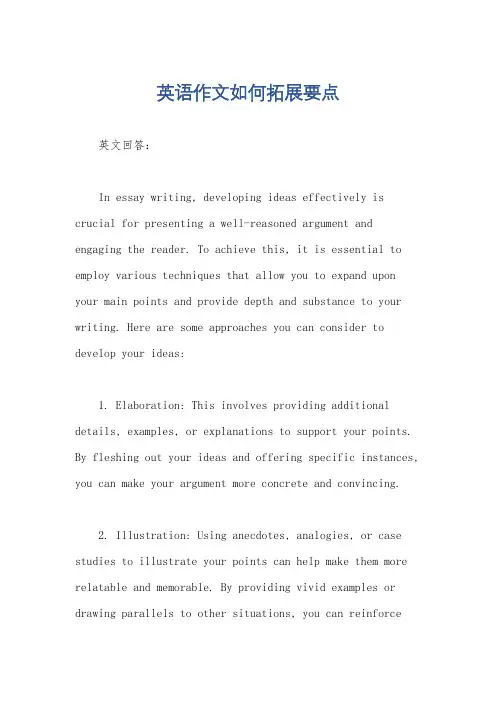
英语作文如何拓展要点英文回答:In essay writing, developing ideas effectively is crucial for presenting a well-reasoned argument and engaging the reader. To achieve this, it is essential to employ various techniques that allow you to expand upon your main points and provide depth and substance to your writing. Here are some approaches you can consider to develop your ideas:1. Elaboration: This involves providing additional details, examples, or explanations to support your points. By fleshing out your ideas and offering specific instances, you can make your argument more concrete and convincing.2. Illustration: Using anecdotes, analogies, or case studies to illustrate your points can help make them more relatable and memorable. By providing vivid examples or drawing parallels to other situations, you can reinforceyour main points and capture the reader's attention.3. Definition: Occasionally, it may be necessary to clarify or define particular concepts or terms used in your argument. By providing concise definitions, you can ensure that the reader has a clear understanding of the ideas you are presenting.4. Comparison and Contrast: Analyzing similarities and differences between different ideas or viewpoints can strengthen your argument. By comparing and contrasting your points with opposing views or alternative perspectives, you can demonstrate the strengths of your position and anticipate potential objections.5. Evidence and Authority: Supporting your points with credible evidence, such as studies, research, or expert opinions, can add weight to your argument. By incorporating external sources and citing authorities, you can establish the validity of your claims and enhance the credibility of your writing.6. Logical Reasoning: Employing logical reasoning and connecting your ideas through transitions and signposts ensures a smooth flow of thought for the reader. By providing clear connections between your points, you can guide the reader through your argument and make it easier to follow.By incorporating these techniques into your writing, you can effectively develop your ideas, provide depth to your argument, and captivate your readers with a well-written and compelling essay.中文回答:扩展主旨的方法:1. 补充说明,提供额外的细节、例子或解释来支持观点。

托福独立写作文章结构如何安排托福独立写作*结构如何安排?常见问题及高分思路分享,下面就和大家分享托福独立写作*结构如何安排,希望能够帮助到大家,来欣赏一下吧。
托福独立写作*结构如何安排?常见问题及高分思路分享托福独立写作总分总结构很LOW吗?说到托福写作的结构,曾有考生问过ETS官方,说中国语文的作文是总分总的结构,托福还是这么写会不会太低端了啊?官方给出的回答是,总分总的篇章安排不叫低端(low),而叫经典(classic)。
我们都说一个写作题目没有标准答案的范文,但是有一个东西可以说是形成了不成文的规定的,那就是一篇好的作文一定是有头有尾、中间细分几段论证的,这一点可以从很多官方给出的范文或是学生的高分*中得到证实。
托福独立写作到底应该写4段还是5段?另外,很多考生还存在疑问的一点在于到底一篇*是写四段还是五段,在看来,两种结构各有利弊所在。
一般写4段式的同学都是因为主体段只能想出两条理由,实在是想不出第三条理由,只能以1+2+1的结构完成*。
大家都知道一般来说要想拿到不错的分数,一篇新托福议论文需要写到400字左右,那么,如果主体段只写两段,势必需要考生在这两个段落的论证细节上写出更多的内容,否则字数撑不到那么多,而这一点对于很多考生来说恰恰也是很有难度的。
相反地,如果写成5段式,貌似就需要考生能想出3条理由进行论证,但事实是,很多考生根本想不到3点理由,能想出2点已经是绞尽脑汁了。
在这种情况下,怎么做才是最简易、最轻松的应对办法呢?比较建议大家写5段式的*,但主体段并不是上文所说的3个理由段,而是采用2+1的模式,即两个理由段,再加一个让步段。
关于理由段的写法,将在下文详细分析,在此先重点解释一下让步段到底是什么意思。
“让步”字面意思是退一步,那么放到我们作文里,意思就是承认一下反方的观点。
西方的*不太喜欢作者全篇一味强调自己观点的正确性,而是需要作者能适当回应并评价一下反方的观点,这样的*看起来会更加有说服力。
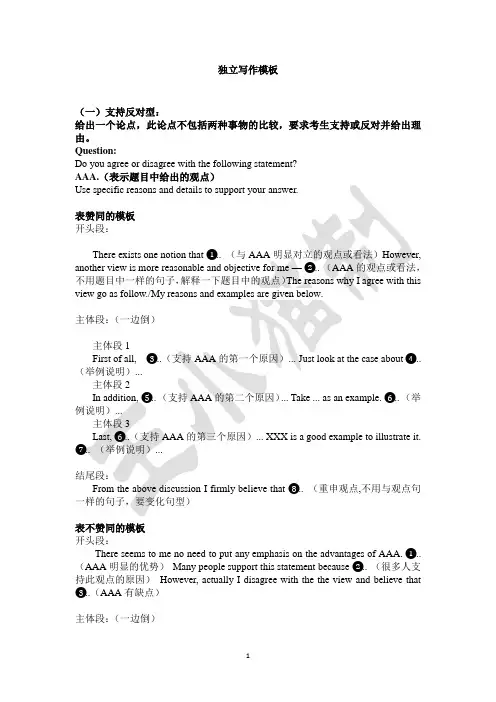
独立写作模板(一)支持反对型:给出一个论点,此论点不包括两种事物的比较,要求考生支持或反对并给出理由。
Question:Do you agree or disagree with the following statement?AAA.(表示题目中给出的观点)Use specific reasons and details to support your answer.表赞同的模板开头段:There exists one notion that ❶... (与AAA明显对立的观点或看法)However, another view is more reasonable and objective for me —❷... (AAA的观点或看法,不用题目中一样的句子,解释一下题目中的观点)The reasons why I agree with this view go as follow./My reasons and examples are given below.主体段:(一边倒)主体段1First of all, ❸...(支持AAA的第一个原因)... Just look at the case about ❹...(举例说明)...主体段2In addition, ❺... (支持AAA的第二个原因)... Take ... as an example. ❻... (举例说明)...主体段3Last, ❻...(支持AAA的第三个原因)... XXX is a good example to illustrate it. ❼... (举例说明)...结尾段:From the above discussion I firmly believe that ❽... (重申观点,不用与观点句一样的句子,要变化句型)表不赞同的模板开头段:There seems to me no need to put any emphasis on the advantages of AAA. ❶... (AAA明显的优势)Many people support this statement because ❷... (很多人支持此观点的原因)However, actually I disagree with the the view and believe that ❸...(AAA有缺点)主体段:(一边倒)主体段1On the one hand, the apparent disadvantage of AAA is ❹...(AAA的第一个缺点。
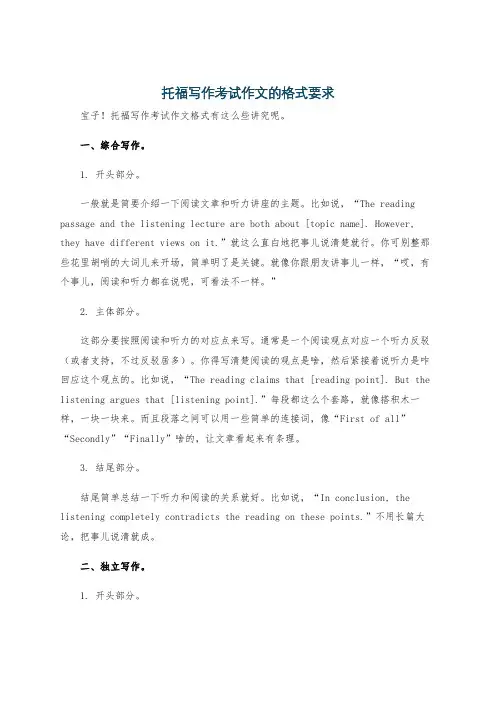
托福写作考试作文的格式要求宝子!托福写作考试作文格式有这么些讲究呢。
一、综合写作。
1. 开头部分。
一般就是简要介绍一下阅读文章和听力讲座的主题。
比如说,“The reading passage and the listening lecture are both about [topic name]. However, they have different views on it.”就这么直白地把事儿说清楚就行。
你可别整那些花里胡哨的大词儿来开场,简单明了是关键。
就像你跟朋友讲事儿一样,“哎,有个事儿,阅读和听力都在说呢,可看法不一样。
”2. 主体部分。
这部分要按照阅读和听力的对应点来写。
通常是一个阅读观点对应一个听力反驳(或者支持,不过反驳居多)。
你得写清楚阅读的观点是啥,然后紧接着说听力是咋回应这个观点的。
比如说,“The reading claims that [reading point]. But the listening argues that [listening point].”每段都这么个套路,就像搭积木一样,一块一块来。
而且段落之间可以用一些简单的连接词,像“First of all”“Secondly”“Finally”啥的,让文章看起来有条理。
3. 结尾部分。
结尾简单总结一下听力和阅读的关系就好。
比如说,“In conclusion, the listening completely contradicts the reading on these points.”不用长篇大论,把事儿说清就成。
二、独立写作。
1. 开头部分。
可以先引出话题。
比如题目是关于“要不要在学校里开设艺术课程”,你可以这么开头,“Hey, have you ever thought about whether art classes should be offered in schools? Well, this is a really hot topic.”然后表明自己的观点,像“I think art classes are definitely necessary in schools.”这里的观点要明确,就像你在跟小伙伴争论一件事,得让对方清楚知道你站在哪边。
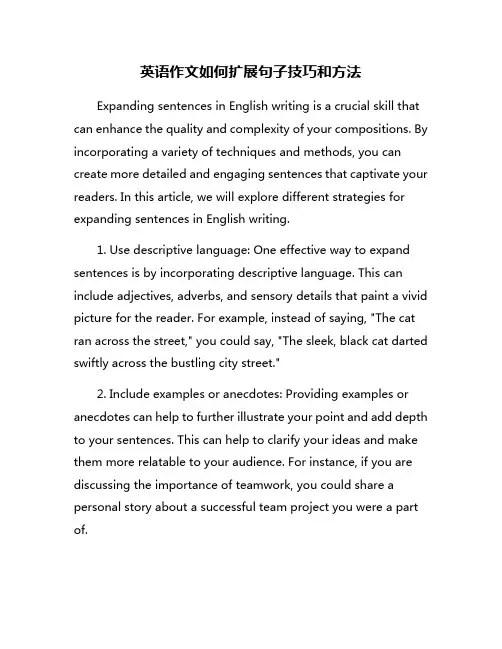
英语作文如何扩展句子技巧和方法Expanding sentences in English writing is a crucial skill that can enhance the quality and complexity of your compositions. By incorporating a variety of techniques and methods, you can create more detailed and engaging sentences that captivate your readers. In this article, we will explore different strategies for expanding sentences in English writing.1. Use descriptive language: One effective way to expand sentences is by incorporating descriptive language. This can include adjectives, adverbs, and sensory details that paint a vivid picture for the reader. For example, instead of saying, "The cat ran across the street," you could say, "The sleek, black cat darted swiftly across the bustling city street."2. Include examples or anecdotes: Providing examples or anecdotes can help to further illustrate your point and add depth to your sentences. This can help to clarify your ideas and make them more relatable to your audience. For instance, if you are discussing the importance of teamwork, you could share a personal story about a successful team project you were a part of.3. Incorporate quotations or citations: Adding quotations or citations from reputable sources can add credibility to your writing and provide additional context for your ideas. This can help to support your arguments and demonstrate that you have done thorough research on the topic. Make sure to properly cite your sources to avoid plagiarism.4. Use transitional phrases: Transition words and phrases can help to connect ideas and create a smooth flow in your writing. This can make your sentences more cohesive and easier to follow for the reader. Some common transitional phrases include "however," "in addition," "on the other hand," and "furthermore."5. Include complex sentences: Complex sentences consist of multiple clauses and can help to add sophistication to your writing. By combining independent and dependent clauses, you can create more nuanced and detailed sentences. For example, instead of saying, "I went to the store," you could say, "After finishing my homework, I went to the store to buy groceries."6. Vary sentence structures: Experimenting with different sentence structures can make your writing more engaging and dynamic. Try using different sentence types, such as compound, complex, or compound-complex sentences, to add variety toyour compositions. This can help to keep your readers interested and prevent your writing from becoming monotonous.7. Revise and edit your work: Finally, it is important to revise and edit your writing to ensure that your sentences are clear, concise, and well-developed. Pay attention to grammar, punctuation, and word choice to make sure that your sentences are polished and error-free. You can also seek feedback from peers or instructors to help you improve your sentence expansion skills.In conclusion, expanding sentences in English writing requires practice, creativity, and attention to detail. By incorporating descriptive language, examples, quotations, transitional phrases, complex sentences, varied sentence structures, and thorough revision, you can effectively enhance the quality and impact of your compositions. Keep these tips in mind as you continue to develop your writing skills and strive to create compelling and engaging sentences.。
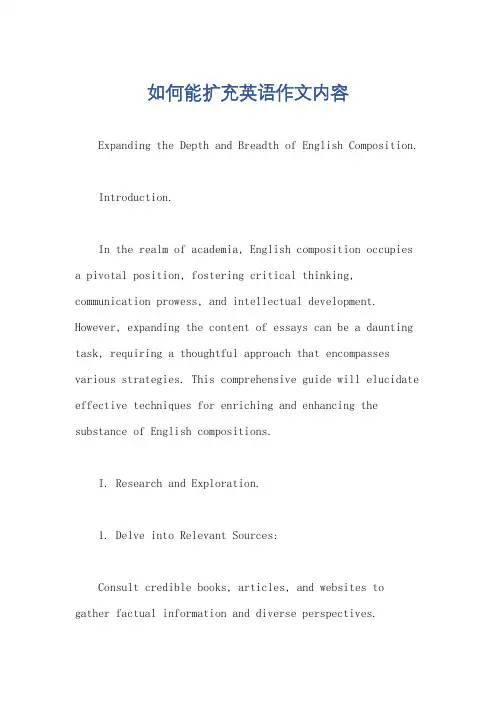
如何能扩充英语作文内容Expanding the Depth and Breadth of English Composition.Introduction.In the realm of academia, English composition occupies a pivotal position, fostering critical thinking, communication prowess, and intellectual development. However, expanding the content of essays can be a daunting task, requiring a thoughtful approach that encompasses various strategies. This comprehensive guide will elucidate effective techniques for enriching and enhancing the substance of English compositions.I. Research and Exploration.1. Delve into Relevant Sources:Consult credible books, articles, and websites to gather factual information and diverse perspectives.Utilize academic databases and specialized search engines to access scholarly works and research papers.2. Interview Experts:Reach out to individuals with knowledge or experience in the topic area.Conduct structured interviews to gather firsthand accounts, insights, and personal anecdotes.3. Explore Personal Experiences:Draw upon your own observations, experiences, and emotions to provide depth and context to your writing.Utilize vivid descriptions, sensory details, and introspective reflections to engage the reader.II. Development and Organization.1. Establish a Clear Thesis Statement:Craft a concise statement that articulates the central argument or position of your essay.Ensure that your thesis is specific, debatable, and supported by evidence.2. Organize Your Essay Logically:Divide your essay into clear sections, such as an introduction, body paragraphs, and conclusion.Use transition words and phrases to guide the reader through your logical flow of thought.3. Develop Supporting Paragraphs:Dedicate each body paragraph to a specific point or aspect of your thesis.Present evidence and arguments that support your claims.Provide transitions within each paragraph to ensure smooth connections between ideas.III. Language and Vocabulary.1. Expand Your Vocabulary:Make a conscious effort to use a range of sophisticated vocabulary appropriate for the topic.Familiarize yourself with synonyms, antonyms, and word roots to enhance your word choice.2. Employ Vivid Description:Use descriptive language to paint a vivid picture for the reader.Appeal to the senses by using sensory details, metaphors, and similes.3. Avoid Clichés and Redundancies:Strive for originality in your language.Avoid using overused phrases or repetitive words that lack impact.IV. Analysis and Interpretation.1. Critically Analyze Your Sources:Examine the credibility, biases, and limitations of your research materials.Evaluate the validity of arguments and identify potential counterarguments.2. Draw Connections and Inferences:Synthesize information from different sources to form new insights and interpretations.Connect ideas and draw logical conclusions based on your analysis.3. Develop a Unique Perspective:Offer your own original analysis and interpretation of the topic.Present a well-reasoned argument that demonstrates your understanding and critical thinking skills.Conclusion.Expanding the content of English compositions requires a multifaceted approach that encompasses research, development, language, and analysis. By employing the strategies outlined above, writers can enhance the depth, breadth, and impact of their essays. Remember, the goal is not merely to fill space but to produce a meaningful and engaging piece of writing that effectively communicates your ideas and perspectives.。
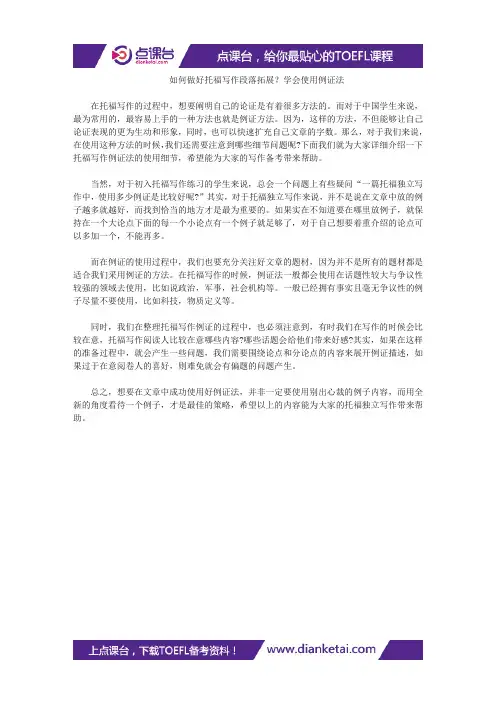
如何做好托福写作段落拓展?学会使用例证法在托福写作的过程中,想要阐明自己的论证是有着很多方法的。
而对于中国学生来说,最为常用的,最容易上手的一种方法也就是例证方法。
因为,这样的方法,不但能够让自己论证表现的更为生动和形象,同时,也可以快速扩充自己文章的字数。
那么,对于我们来说,在使用这种方法的时候,我们还需要注意到哪些细节问题呢?下面我们就为大家详细介绍一下托福写作例证法的使用细节,希望能为大家的写作备考带来帮助。
当然,对于初入托福写作练习的学生来说,总会一个问题上有些疑问“一篇托福独立写作中,使用多少例证是比较好呢?”其实,对于托福独立写作来说,并不是说在文章中放的例子越多就越好,而找到恰当的地方才是最为重要的。
如果实在不知道要在哪里放例子,就保持在一个大论点下面的每一个小论点有一个例子就足够了,对于自己想要着重介绍的论点可以多加一个,不能再多。
而在例证的使用过程中,我们也要充分关注好文章的题材,因为并不是所有的题材都是适合我们采用例证的方法。
在托福写作的时候,例证法一般都会使用在话题性较大与争议性较强的领域去使用,比如说政治,军事,社会机构等。
一般已经拥有事实且毫无争议性的例子尽量不要使用,比如科技,物质定义等。
同时,我们在整理托福写作例证的过程中,也必须注意到,有时我们在写作的时候会比较在意,托福写作阅读人比较在意哪些内容?哪些话题会给他们带来好感?其实,如果在这样的准备过程中,就会产生一些问题,我们需要围绕论点和分论点的内容来展开例证描述,如果过于在意阅卷人的喜好,则难免就会有偏题的问题产生。
总之,想要在文章中成功使用好例证法,并非一定要使用别出心裁的例子内容,而用全新的角度看待一个例子,才是最佳的策略,希望以上的内容能为大家的托福独立写作带来帮助。
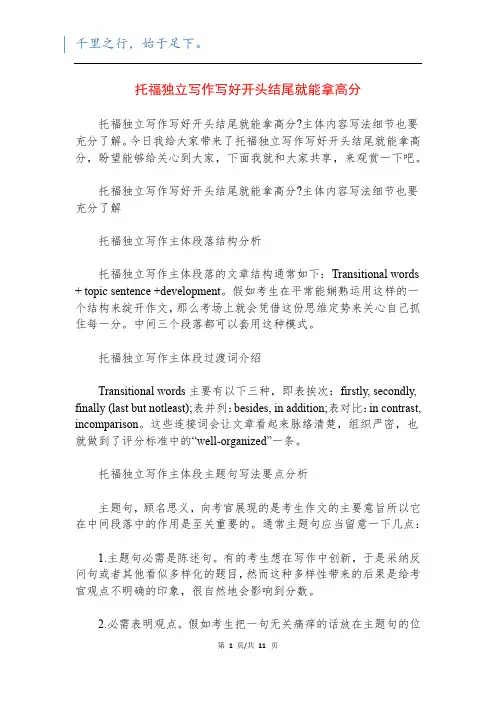
托福独立写作写好开头结尾就能拿高分托福独立写作写好开头结尾就能拿高分?主体内容写法细节也要充分了解。
今日我给大家带来了托福独立写作写好开头结尾就能拿高分,盼望能够给关心到大家,下面我就和大家共享,来观赏一下吧。
托福独立写作写好开头结尾就能拿高分?主体内容写法细节也要充分了解托福独立写作主体段落结构分析托福独立写作主体段落的文章结构通常如下:Transitional words + topic sentence +development。
假如考生在平常能娴熟运用这样的一个结构来绽开作文,那么考场上就会凭借这份思维定势来关心自己抓住每一分。
中间三个段落都可以套用这种模式。
托福独立写作主体段过渡词介绍Transitional words主要有以下三种,即表挨次:firstly, secondly, finally (last but notleast);表并列:besides, in addition;表对比:in contrast, incomparison。
这些连接词会让文章看起来脉络清楚,组织严密,也就做到了评分标准中的“well-organized”一条。
托福独立写作主体段主题句写法要点分析主题句,顾名思义,向考官展现的是考生作文的主要意旨所以它在中间段落中的作用是至关重要的。
通常主题句应当留意一下几点:1.主题句必需是陈述句。
有的考生想在写作中创新,于是采纳反问句或者其他看似多样化的题目,然而这种多样性带来的后果是给考官观点不明确的印象,很自然地会影响到分数。
2.必需表明观点。
假如考生把一句无关痛痒的话放在主题句的位置上,很明显无法表明自身观点。
比如像“今日是晴天”这样的话没有表明观点;然而“今日是个好天气”就包含一种感情颜色在里面,给人一种立场明确的感觉。
考生应当切记:没有反对余地的就不行以作为主题句。
3.态度必需坚决。
但是不能极端。
4.每段必需有主题句,理论上讲没有主题句是可以的,但是考场上不行以,没有主题就会铺张考官的时间去帮你总结主题,然而繁忙的考官是不会那么和善地去分析你的题目来抓取你的观点的。
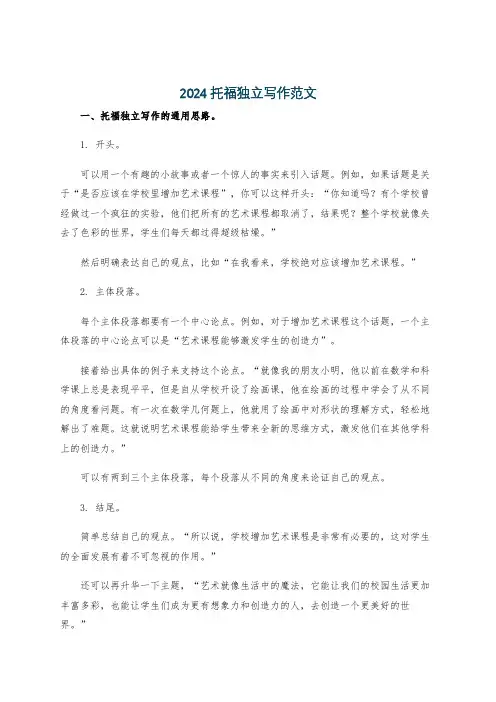
2024托福独立写作范文一、托福独立写作的通用思路。
1. 开头。
可以用一个有趣的小故事或者一个惊人的事实来引入话题。
例如,如果话题是关于“是否应该在学校里增加艺术课程”,你可以这样开头:“你知道吗?有个学校曾经做过一个疯狂的实验,他们把所有的艺术课程都取消了,结果呢?整个学校就像失去了色彩的世界,学生们每天都过得超级枯燥。
”然后明确表达自己的观点,比如“在我看来,学校绝对应该增加艺术课程。
”2. 主体段落。
每个主体段落都要有一个中心论点。
例如,对于增加艺术课程这个话题,一个主体段落的中心论点可以是“艺术课程能够激发学生的创造力”。
接着给出具体的例子来支持这个论点。
“就像我的朋友小明,他以前在数学和科学课上总是表现平平,但是自从学校开设了绘画课,他在绘画的过程中学会了从不同的角度看问题。
有一次在数学几何题上,他就用了绘画中对形状的理解方式,轻松地解出了难题。
这就说明艺术课程能给学生带来全新的思维方式,激发他们在其他学科上的创造力。
”可以有两到三个主体段落,每个段落从不同的角度来论证自己的观点。
3. 结尾。
简单总结自己的观点。
“所以说,学校增加艺术课程是非常有必要的,这对学生的全面发展有着不可忽视的作用。
”还可以再升华一下主题,“艺术就像生活中的魔法,它能让我们的校园生活更加丰富多彩,也能让学生们成为更有想象力和创造力的人,去创造一个更美好的世界。
”二、托福独立写作的技巧。
1. 语言表达。
不要使用过于复杂、生僻的单词,但是要保证用词准确。
用“big”不如用“enormous”或者“huge”更能体现词汇量。
多使用连接词,像“firstly”“secondly”“in addition”“moreover”“however”等,这样可以让文章的逻辑更清晰。
2. 避免语法错误。
在写作过程中要注意主谓一致、时态一致等基本语法规则。
写完后可以快速检查一下。
3. 针对题目要求。
一定要仔细阅读题目,确保自己的文章是紧扣题目要求来写的。
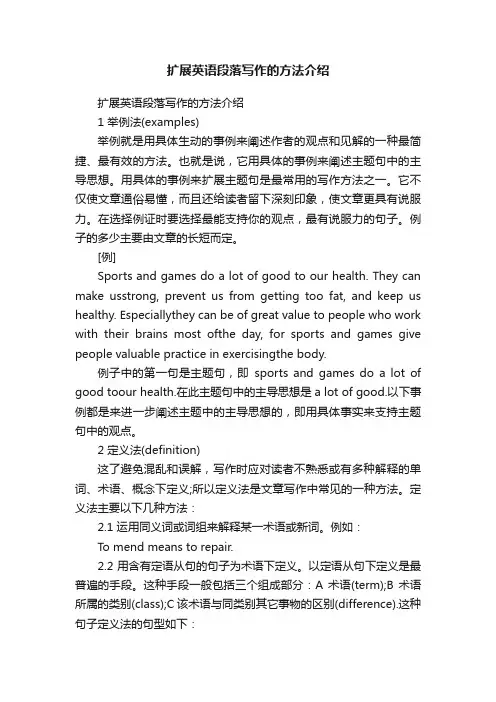
扩展英语段落写作的方法介绍扩展英语段落写作的方法介绍1 举例法(examples)举例就是用具体生动的事例来阐述作者的观点和见解的一种最简捷、最有效的方法。
也就是说,它用具体的事例来阐述主题句中的主导思想。
用具体的事例来扩展主题句是最常用的写作方法之一。
它不仅使文章通俗易懂,而且还给读者留下深刻印象,使文章更具有说服力。
在选择例证时要选择最能支持你的观点,最有说服力的句子。
例子的多少主要由文章的长短而定。
[例]Sports and games do a lot of good to our health. They can make usstrong, prevent us from getting too fat, and keep us healthy. Especiallythey can be of great value to people who work with their brains most ofthe day, for sports and games give people valuable practice in exercisingthe body.例子中的第一句是主题句,即sports and games do a lot of good toour health.在此主题句中的主导思想是a lot of good.以下事例都是来进一步阐述主题中的主导思想的,即用具体事实来支持主题句中的观点。
2 定义法(definition)这了避免混乱和误解,写作时应对读者不熟悉或有多种解释的单词、术语、概念下定义;所以定义法是文章写作中常见的一种方法。
定义法主要以下几种方法:2.1 运用同义词或词组来解释某一术语或新词。
例如:To mend means to repair.2.2 用含有定语从句的句子为术语下定义。
以定语从句下定义是最普遍的手段。
这种手段一般包括三个组成部分:A 术语(term);B 术语所属的类别(class);C 该术语与同类别其它事物的区别(difference).这种句子定义法的句型如下:Term(术语)=its general class(基本属类)+ how it is different 例如:A generator is an apparatus which produces electricity.2.3 扩展式定义:有时一个术语或概念比较复杂或比较重要,用同义词定义或用句子定义还不能够明确解释清楚,或容易与其它同类词混淆时,则有必要使用扩展式定义。
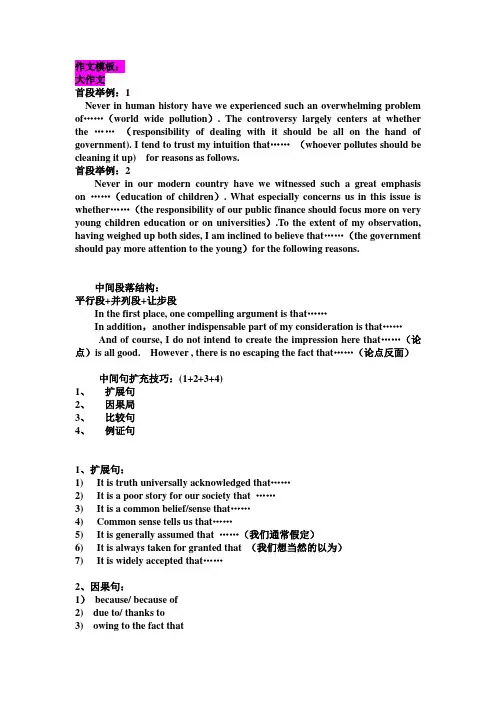
作文模板:大作文首段举例:1Never in human history have we experienced such an overwhelming problem of……(world wide pollution). The controversy largely centers at whether the ……(responsibility of dealing with it should be all on the hand of government). I tend to trust my intuition that……(whoever pollutes should be cleaning it up) for reasons as follows.首段举例:2Never in our modern country have we witnessed such a great emphasis on ……(education of children). What especially concerns us in this issue is whether……(the responsibility of our public finance should focus more on very young children education or on universities).To the extent of my observation, having weighed up both sides, I am inclined to believe that……(the government should pay more attention to the young)for the following reasons.中间段落结构:平行段+并列段+让步段In the first place, one compelling argument is that……In addition,another indispensable part of my consideration is that……And of course, I do not intend to create the impression here that……(论点)is all good. However , there is no escaping the fact that……(论点反面)中间句扩充技巧:(1+2+3+4)1、扩展句2、因果局3、比较句4、例证句1、扩展句:1)It is truth universally acknowledged that……2)It is a poor story for our society that ……3)It is a common belief/sense that……4)Common sense tells us that……5)It is generally assumed that ……(我们通常假定)6)It is always taken for granted that (我们想当然的以为)7)It is widely accepted that……2、因果句:1)because/ because of2) due to/ thanks to3) owing to the fact that4) the reason(结果) is that (原因)5)A contribute to B = A lead to B6) B result from A7) sb. attributes B to A = B is attributed to A3、比较句:1)unlike (like)……2)just as ……,……3)compared to……,……4)A is (not)as ……as B5)A is superior to B; A is inferior to B4、例证句:1) 个人经历:personally,My personal experience tells me that……2)其他事件:for example;for instance ; A case in point is thatW e don’t have to look further than the case of……,to find Support of this idea/ argument.To illustrate this viewpoint, I can not fink of a better example than……3)数据调查:we are living in exponential times. According to the statistics,it is predicted that…Data from a recently conducted survey by a related department estimated that……Sometimes,number does number. It is estimated that/ to be ……(有时,数字不愧是数字,它显示出)4/让步段材料;1)however, they overlook one basic fact that2) a singular example may never lead to any universal truth3)they only stand on the behalf of the minority4)they fail to look at the matter in the long run5)they fail to look at the whole picture6)Nevertheless, what I need to emphasize here is that most of these issuescan be solved or even prevented with the development of technology.并列段举例:In the first place, one compelling argument is that the improvement in modern transportation and accommodation has brought convenience in people’s life. It is common belief that the rapid development of our daily means of transport such as bus, automobile, subway and so on has a significant effect on human life. Owing to the fact, people can save time and take easy way to commute during hour traffic. To illustrate this viewpoint, I can not think of a better example than private cars. Compared with walking on foot, it isdramatically fast and driving is not as complicated as operating a carriage. The importance of modern technology is clear to us.In addition,another indispensable part of my consideration is that the efficiency in communication has been greatly improved by the development of technology. It is a truth universally acknowledged that the modern society has a desperate need for efficiency especially in commercial practice or an educational environment. Compared to the past, it took people then one to six months to write letters and made it reach to other end of communication, if the distance was too far away. The present-day society has witnessed the huge amount of time being saved by using computers and E-mails. Sometimes, this can be minimized to as quickly as one second.And of course, I do not intend to create the impression here that technology is all good. However, there is no escaping the fact that technology also has some disadvantages like wars, pollutions, and the decline of our health. W e admit that some modern problems of society ar e attributed to the application of the bad parts and the mistaken extension beyond our law and humanity. Nevertheless, what I need to emphasize here is that most of these issues can be solved or even prevented with the development of technology. They fail to look at the matter in the long run.结尾段落:(表态+论述)1)、转述论点2)、总结论点3)、引申结束In the final analysis, I am still of the firm opinion that……,and sum up the given reasons discussed above, we can safely reach the conclusion that choosing……is a rather wise decision if…….结尾段示例:In the final analysis, I am still of the firm opinion that it is necessary for college students to work on a part-time job during there college years. And sum up the given reasons discussed above, we can safely r each the conclusion that choosing part-time job is a rather wise decision if these students pay more attention to their safety problems and try not to be money-obsessed individuals. It is on a whole an optional act to us to work before graduation.小作文综合写作:Introduction:●Overall, the speaker refutes(反驳) the reading materials argument about___1主题___ by providing contradictory(反对的)evidence concerning several critical respects (aspects) listed below.●In summary, the lecture casts serious doubt on the reading passages in thediscussion of whether ___1主题____ by questioning the following essential parts of the argument.Body paragraph 1:●The speaker begins by pointing out that___2听力反驳的第一个层面___●While the reading passages maintains that___3阅读的相关内容____,thispoint is invalidated by the listening material because the speaker argue that___*4听力第一论据____Body paragraph 2:●Next, the Speaker continues his refutation against the view expressed in thereading with the aid of the fact that___*5听力材料第二层面___.●Although ___6阅读相关内容____, the speaker completely disagrees it andprove that ____*7听力第二论点的论据___.Body paragraph3:●In terms of ___8听力第三个层面___, the passage and the lecture reachnothing but a disagreement.●Differing from the former which claims that____9阅读相关内容___, thelatter remains a suspicious attitude that___*10 听力第三点论据___.综合写作例文:Overall,the speaker refutes the reading materials argument about The School Uniform Policy, by providing contradictory evidence concerning several aspects listed below. In summary, the lecture casts serious doubt on the reading passages in the discussion of whether schools should implement a compulsory School Uniform Policy.The speaker begins by pointing out that cost and expenses in carrying out this policy. While the reading passage maintains that wearing school uniform is to reduce family’s economic burden, this point is invalidated by the listening material because the speaker argues that school uniform will require additional spending of buying more cloths and they are not very likely to be wore for a long time.Next, the speaker continues his refutation against the view expressed in the reading with the aid of the fact that it has a negative influence on students’academic performance. Although this policy tends to reduce transformation and save time in choosing cloths, students show the opposite result and may do harm to individual students taste and freedom.In terms of the connection between wearing trendy cloths and occurrence of violence events, the passage and the lecture reach nothing but a disagreement. Differing from the former which claims that to wear personal and fashionable clothes may incur violence in school environments, the latter remains asuspicious attitude that this approach is far from effective and suggests that alternative methods such as being kind, walking with company and so on.口语:第一题:personal preferenceWhat:观点表达句+比较级According to my understanding,the greatest leader of all times was Mahatma Gandhi . and I have several reasons for that.Why:to begin with,——,for example,——Besides,——,simply because,——So,——替换:I think/ believe/ suppose / guess/ betIn my opinion/ I assume thatAccording to my understandingAs far as I am concernedI hold the opinion thatI am under the impression thatI got the feeling that并列结构:To begin with;Also,personally speakingFor one thing;nevertheless,I believe thatFirst and foremost;in additionFor one thing;in the second place,First;That,however,……Like & Dislike:My favorite ……isI love/ enjoy/ have a fancy for/ have a great affection forI care for/ do fancy forI find my self addicted toI absolutely am into/ crazy aboutI am a (mobile) nut/ a big funSth. Entertains/ relaxes/ amuses/ recreates me more than anyting else in the world.Sth. kills most of my spare timesth. is my most effective time killer/ pain killerReasons & Examples:Why this is my favorite? One reason is that……Couple of reasons for thatAnd I have several reasons for that.GE & SEI like all kinds of music, including jazz, blues, and classical.I like music especially classical ones, well, Mozart for example.人物卡:W ell, as far as I am concerned, X is the most helpful teacher to me, and I have two main reasons for that. To begin with,he is really concerned about all the students in his class. For example, he would meet with me and other students after class to make sure that we understand his lessons. Also, personally speaking, he is of great help to those ambitious students who were eager to attend the foreign universities fill out their applications and edit their personal statement till very late.W ell, to be honest, I got the felling that good parents all distinguished themselves in treating their child patiently with an open mind. For one thing, it often takes many efforts to teach their kid about good and bad. Sometimes when kid gets very radical the parents needs to be patient enough to bring him or her back to the track. In addition a good parent also needs to be supportive enough when the child raises a reasonable request. If the kids are in trouble they should trust the kids to make their own decisions, like how to spend their pocket money or which study group to join. Only such parent can one make a good parent.W ell, according to my understanding, Lance Armstrong is my most admirable role model for several reasons. First and foremost, he is a cyclist who has won the Tour de France seven times in a row. That, however, is not the only reason I respected this man. He also battled the cancer. When I heard his story, it changed my life. Lance Armstrong inspired me to never give up my dream of going to the Olympics, even though it may seem impossible. All in all, his qualities of endurance and perseverance compelled me to become a better athlete and a stringer person.物品卡:In my opinion, the most distinctive thing in my daily life is my cell phone, because it has amazingly changed my life in two main aspects. To begin with, it helps me communicate with the world around me. For example, by using my cell phone, I could keep in touch with my friends, family members, classmates, you know, everyone! And even in dangerous situations, it could even save my life. I will just have to make a call telling others that I am in danger. More importantly, if I have to say, it’s also a great entertainment. When I get bored, it’s a music box, because my favorite MP3 music and MP4 movie-clips within my cell will easily cheer me up.W ell, without doubt, I’d like to say comedy amuses me most and I have a couple of reasons. First and foremost, it’s so relaxing. Whenever I want to watch a movie, more often than not, I’m looking for something fun, something thatrelieves my tiredness or sadness. A comedy fits my demand perfectly, as it’s nothing doctrine to teach seriously unlike documentaries, or tragedies or tear-jerkers and so on. Besides, Zhou Xing chi is the most famous and welcome joking star in my country, for 2 years I only focus on his shows, comedies of course. That’s why I really into all sorts of comedies, since they make me laugh every time and forget myself.I think computer is the most important invention in the recent 100 years for the following reasons. For one thing, computer connects the whole world as closely as possible so that different people can share information and communicate with each other by new methods, such as MSN, QQ, and E-mail. In addition, computer has also pushed the increasing trends of science and technology, based on their amazing calculating ability has been applied in the most high-tech fields, many software are developed to help research in other disciplines.事件卡W ell, in my opinion, my 20th birthday, my first surprising party held by my friends, surprised me most, and I have 2 main reasons for that. First of all, I was amazed by the definition of true friendship as some of my old friends traveling 2 hours by airplane coming to celebrate my birthday, who attacked me dramatically with a birthday cake. Another thing that was surprising and touching to me was that they took a photo of me which made the whole occasion unforgettable. Finally, they sang a birthday song for me according to western tradition, which is totally beyond my expectation.I got the feeling that just as people in western countries do, we Chinese hold Spring Festival to celebrate our lunar new year, which is the biggest event for each family as well as the whole nation. First, on the eve there usually is a big family reunion, and all families from all over China will be sitting around the same table, feasting, toasting and chitchatting. At 12 o’clock, we set off fire works and let our crackers in order to celebrate the coming of New Y ear. And after that, we visit our friends and relations to send our best wishes.地方卡W ell, as far as I am concerned, a forest would be my dream land for residence, and I have two main reasons for that. First of all, it is a fantastic way of embracing the great nature. If I got a chance, I would choose to build a splendid garden with whole lot of flowers, which will relieve me from strains burden. Besides, the tropical weather that I will enjoy is a perfect natural environment. For example, I don’t have to worry about the off-gas from automobiles, nor dazzling reflection of sun light from modern skyscrapers at all.W ell, I hold the opinion that living in a modern apartment with large roomswould be a wise decision, and I have two main reasons for that. First, I could always feel relaxed inside, since it has high ceilings and only a few pieces of modern furniture so it would feel more spacious than ever. Besides, I am also crazy about all the big picture windows that I could throw open in summer, so that the whole place would be light and airy. And so my room like that will really lift my spirits whenever I feel down or upset.第二题;paired choice二选一题:A or B ——preferA or 非A ——agree or disagree模板1:W ell, in such a dilemma, I believe __A__ is definitely a better choice in contrast with ___B__. And I have two main reasons for that.First of all, I believe that……, for exampleWhat’s more, I insist that__A1好__,simply because(on the other hand, __B1不好___, obviously, if not___)So,if I have to choose,I think A is apparently a better one。
英语考试作文托福写作格式独立写作常见的两种写作格式托福写作包括综合写作和独立写作两部分,综合写作主要考察大家对信息的归纳总结能力,独立写作考察大家英文写作能力。
独立写作想要写好并不容易,需要多加练习,并掌握一些写作技巧。
下面,来给大家介绍一下托福独立写作中常见的两种写作格式。
一.单边论证格式单边论证格式具体写作格式如下:Introduction(引入正文)Background+My Opinion(亮明观点)Body:1.Reason One + Supportiong Sentences(ss表示)(分列论据)2.Reason Two + SS3.Reason Three + SSConclusion:Restatement of My Opinion(总结观点)上述结构中的supporting sentences在议论文中的体现方式是一些论证方法,如举例子(exemplification),对比对照(contrast& comparison),列数据(raising figures),让步(making concession)等来对自己支持的观点进行论证,使考官信服。
而此类结构也是中国学生较熟悉的议论文结构,在各类中国的考试中,如高考英语、大学四六级考试等,应用也较广。
但是单边论证的缺点,就中国学生而言,是较难扩展论证过程,而且像讲道理、举例子等论证方法必须正确使用,显示其逻辑性才能得到高分。
二.双边倾向结构双边倾向结构的文章结构如下:Introduction(引入正文)Background+ My Opinion / Layout(亮明观点)Body:1. Opinion One/ Advantage(论述观点一的优点)Topic sentence+ Reason One + Supporting Sentences+ Reason Two + Supporting Sentences2. Opinion Two/ Disadvantage(论述观点二的缺点)Topic sentence+ Reason One + Supporting Sentences+ Reason Two + Supporting Sentences+ Reason Three + Supporting SentencesConclusion:(总结)Statement of My Opinion (for opinion two/ more disadvantages than advantages)此类结构是双边倾向性结构,是双边结构中的一种。
2023年4月26日托福写作真题及写作建议思路一、独立写作(重复2023年3月18日考题)Do you agree or disagree with the following statement? Because economic growth is so important for modern societies, economic development should not be slowed down by concerns about the environment.Use specific reasons and examples to support your answer.你是否同意:由于经济增长对现代社会很重要,所以经济发展不应该因担心环境而减缓。
题目解析:本场考试不仅重复了3月18日考试的原题,还延续了本月的环境主题。
题干中有两个关键词:economic growth和environment concerns,因此在写作中需要时刻注意保持两个关键点的论述均衡,不要只讲环境的重要性、或者只讲经济的重要性。
同时,熟悉托福写作的套路的同学,应该很容易发现,这两个点对于现代社会而言是缺一不可的,那么如何在保持缺一不可的论调下,同时回答agree or disagree呢?思路参考: agree让步段: 环境对于现代社会确实很重要。
环境会影响人们的健康和生活,如果工厂一味追求生产和降低成本,不顾及废水、废弃物的排放和处理,造成环境污染,比如水源污染,那么周边生活的居民罹患疾病的几率也会增加。
同时,环境保护也能促进经济增长,尤其是现代社会,无论是投资、旅游,还是求学、就业,人们都更倾向于选择更好环境的城市。
比如被誉为“花园城市”的新加坡,优美的环境为他吸引了大量的外国游客和投资客,带动了旅游业和商业发展。
但是,保护环境并不意味着要牺牲经济增长,经济持续增长是可以同促进环境保护的。
理由1: 经济增长是现代社会发展的基石,无论是国民生活还是环境保护,都需要有经济作为支柱。
托福独立写作范文三两招突破独立写作系列为了让大家更好的预备托福考试,我给大家整理一些托福考试作文小技巧,下面我就和大家共享,来观赏一下吧。
托福独立写作范文| 三两招突破独立写作系列(一)写作范文今日一招:“四两拨千斤”解读:一句话完成“对比”性的争论“Do you agree or disagree with the following statement?It is better to work for a business owned by someone else than to work for a business owned by your family.”我们以【立场:work for a business owned by someone else】为例,展现这一招“四两拨千斤”:先争论对方的劣势:假如work for a business owned by my family,可能会让我感到不适。
If I work for a business owned by my family, the atmosphere of the company may feel strange, making me uncomfortable. This is my case, actually. I declined the offer from my uncle’s company for theconsideration that since I may be recognized as the nephew of the company’s owner, other staff may show a defensive attitude and gesture when they work with me. They may exchange ideas behind my back, and although those ideas may not be bad words about the company, they would not involve me in the discussion. Meanwhile, the office may be a stressful place, because there in their eye is a spy or a snitcher, which is me. I do not think that I could feel comfortable working in such an environment as my coworkers would behave with too much discretion in front of me.至此,我们发觉,我们充分争论了对方的不利之处。
如何增加英文作文內容英文,Increasing the content of an English essay can be a daunting task, but with some strategies and creativity,it's achievable. First and foremost, expanding on eachpoint you make is crucial. Instead of just stating facts, delve deeper into each idea, providing examples, anecdotes, or even personal experiences to support your argument.For instance, if I'm writing an essay about thebenefits of traveling, I could start by explaining how traveling broadens one's horizons. I would then elaborate on this point by sharing my own experience of traveling to different countries and how it opened my eyes to diverse cultures and perspectives. Additionally, I might include statistics or quotes from experts to reinforce my argument.Another effective way to increase the content of your essay is to anticipate and address counterarguments. This not only demonstrates critical thinking but also adds depth to your writing. By acknowledging opposing viewpoints andrefuting them with evidence or logical reasoning, you strengthen your argument and make your essay more persuasive.Furthermore, incorporating relevant background information or context can help enrich your essay.Providing historical or cultural context not only adds substance to your writing but also shows your understanding of the topic. This could involve discussing the historical significance of an event, the cultural norms of aparticular society, or the scientific principles behind a concept.Moreover, don't underestimate the power of transitions and linking words. These not only improve the flow of your essay but also allow you to connect ideas seamlessly, making your writing more coherent and engaging. Phraseslike "furthermore," "in addition," "on the other hand," and "conversely" can be used to transition between paragraphsor introduce new points.Lastly, revisiting and revising your essay is essential.Editing allows you to refine your ideas, clarify your arguments, and eliminate any unnecessary or redundant information. It's also an opportunity to check for grammar, punctuation, and spelling errors, ensuring that yourwriting is clear and polished.中文,增加英文作文的内容可能是一项艰巨的任务,但通过一些策略和创造力,是可以实现的。
托福写作题型简介及备考策略——独立写作托福写作有分为独立写作和综合写作两个部分今天小编就来和大家分享一下独立写作的题型简介以及备考策略,希望对大家有帮助!托福写作题型简介及备考策略——独立写作1 托福独立写作介绍1.1 典型问法托福独立写作部分(the Independent Writing Task)为新托福写作试题的第二个部分,要求考生针对某个问题提出自己的论点并展开,考试时间为30分钟。
这种题目的典型问法为:Do you agree or disagree with the following statement?[A sentence or sentences that present an issue appear here]Use specific reasons and examples to support your answer.1.2 评分原则和评分标准评分原则:从2010年1月开始,iBT写作评分系统做出重大改革。
由原来的两位阅卷者独立阅卷给分,两个分数的算术平均值为原始分,改为一个阅卷人和一个电脑评分系统(E-Rater)分别给分。
其中,E-Rater负责Linguistic feature(语言因素),即语法,句法和结构;人工负责文章内容和含义;两部分相加,即为考生的作文原始分。
而最终的分数则与原始分所占的百分比(Percentile)相关:比如30分对应97.9%,即只有2.1%的人得到了满分。
评分标准:Score 5: An essay as this level largely accomplishes all of the following:Effectively addresses the topic and task;Is well-organized and well-developed, using clearly appropriate explanation, exemplifications, and/or details;Display unity, progression and coherence;Display consistent facility in the use of language,demonstrating syntactic variety, appropriate word choice and idiomaticity, though it may have minor lexical or grammatical errors.评分标准解读:阅卷人会从考生是否切题,如何展开论点,如何组织文章结构和语言运用四个方面评估考生的文章。
托福独立写作主体段写法技巧——单一观点篇托福独立写作对于很多托福考生来说是取得高分难以逾越的一道鸿沟,这不仅需要大量的练习,还需掌握其中的诀窍。
今天,小编为各位考生带来托福独立写作主题段单观点的写法点拨,希望对各位考生有所帮助。
托福独立写作主体段写法技巧——单一观点篇通常对于独立写作我们都会选择五段式的结构,这个结构包括三个主体段,按照题型我们可以将写作类型分为三个:支持反对类(单观点)、对比比较类(双观点)、自主定义类。
首先我们要明确一下定义,单观点话题就是说题目只要求考生表明自己的态度,支持或反对,并且题目中没有任何要求拿来作比较的对象。
今天,闫玲娟老师跟各位考生分析一下有关单观点类题目的写作技巧,下面是一道典型的题目:Topic 2007.11.3People who do not work because they have enough money are rarely happy.这道题就是一道典型的单观点题目,“那些因为有足够的钱而不去工作的人,他们鲜少开心。
”针对单观点话题主体段的展开有两种方式,举例我们支持是A观点,先来看第一种写法。
1. A+A+A这种写法代表着我们需要用三个理由支持自己的选择。
Topic:It is desirable to know about events from all over the world even if it is unlikely to have any effect on your daily life.了解世界各地发生的事情是好的,纵使这些事不会对我们的日常生活产生任何影响。
1. To begin with, being aware of these cultural events means having more topics for communication.2. In addition, learning news about science is necessary for us to form correct world views in today’s fast-changing society.3. In the end, understanding political incidents serves as an excellent method to broaden our horizons.在这种写法里考生可举出了三个论点正向支持自己的态度,认为了解这些事情是必要的。
托福独立写作正文段如何拓展
托福写作技巧——因果关系论点如何写
如何避免我们在解释中常犯的这两种问题,大家只需要知道解释的本质就行了。
什么叫解释?我们说过,任何独立写作的主题句,其实都是一个小的因果关系,都是A能带来B,我们怎么能证明——A能带来B呢,其实我们要做的非常简单,只要找到一个中间点C,如果这个中间点C确定下来以后,我们说话的顺序就完全是固定的: 第一句话是A能带来C,而第二句话就是C能带来B。
或者我们作一个比方,把逻辑链想象成要搭一座桥,A 是河的左岸,B是河的右岸,你如何让河的左岸和右岸联系到一起呢?很简单,找到一个桥C,只要C固定下来,第一句话A能带来C,第二句话C能带来B,这个解释就算是完成了,而且非常地有细节,非常地完整,
再回到两个失败案例上,我们先从生活的例子开始看起。
日常生活中想要去解释的时候,比如说,一个男孩想要表白的话,最常说的一句很朴素的话就是你要做我女朋友。
他要说服对方,你要做我女朋友。
其实他要建立的是,你和女朋友的关系,那他往下就会要找到一个中间点C,他可能往下接着会说,因为我觉得你萌萌哒。
所以整句话是,因为你萌萌哒,所以你要做我的女朋友。
这个时候你会发现这个孩子好像还真的少说了半句话,他的逻辑链,其实少了后半条,叫,萌萌哒的女孩才能做我的女朋友。
那他为什么在日常生活中,为了证明你要做我女朋友的时候不再说后半句呢,因为我们觉得,萌萌哒的人才能做我的女朋友其实是一个common sence的东西。
也就是说,只要你不说,别人全部都能听懂,那这样子的话,我们就会潜意识中就会省略后半句。
但是,省略不代表没有,这在逻辑学中,叫一个unstated premise就是没有一个说出来的前提,没有说出来不代表它不存在,只是我们没有说出来而已。
或者是我们再看第二个例子,如果你向我说,“他们俩要分手了。
”你要证明是什么,是他们和分手之间的关系。
为了说服我,他们真的要分手了,你可能也会找到一个中间点C。
因为他们俩最近老打架,可能你又不说话了。
但是,从逻辑学的角度来讲,我们还少说半句话,这半句话叫:打架会导致分手。
为什么日常生活中我们就只说前半段他们经常打架,而不说后半段打架会导致分手呢?因为你觉得这非常的common sense.
日常生活中,其实你要建立起A和B的关系的时候,也是找到一个C,只是我们经常少说半句话,因为你觉得是common sense。
但是如果我们在写托福写作的时候,我觉得大家完全可以不用省C到B,因为我们本来就是为了凑词嘛,我们把C到B说出来以后你会直接在多了十几、二十个词,而且你说完以后,别人还会觉得你说话特完整。
再回到刚才那道题,怎么建立高薪不稳定的工作和提高的关系?这个逻辑链的起点,就是高薪不稳定的工作,那逻辑链的终点就是提高,我们要做的很简单,还是找到一个中间点C,这个C其实非常好想。
高薪不稳定的工作会带来什么,让我们变的更强?我觉得非常
简单,可以直接说因为它会给我们带来压力。
所以如果C选定的话,我们说话的顺序完全是固定的。
我们第一句子要讲的是A
能带来C。
也就是说,高薪不稳定的工作,会给人们带来很大的压力。
而我们第二句话要讲的是C能带来B,压力不是一件坏事,压力会让人获得进一步的提高。
成文以后,就是这样两句话,这样两句话虽然不长,但是这样两句话,是一个非
常完整的reason,因为他多出来一个非常新的信息叫C,有这个C的存在,别人就会觉得,你的reason是有细节的。
那往下我们再看,这个reason又非常的完整,为什么呢?我们的主题句是以A开始,B结束,而我们的reason跟主题句完全对应,还是从A开始,B结束,第一句话建立起高薪不稳定的工作和压力的关系。
第二句话建立起压力和提高的关系,我们这样说话的时候,大家还会觉得,我们的语言非常的流畅,原因很简单,上一句的结束,压力,就是下一句的开始,流畅感就是这么产生的。
你会发现流畅的文章总是有点小小的重叠的,
综上我们的reason应该如何写,记住两个词就行,这两个词叫搭桥,主题句是A 能带来B。
你要做的,就只是找到一个桥C,C固定下来以后,我们第一句话就是A能带来C,第二句话C能带来B,这个reason非常地好写,非常地量化,而且它有细节,并且完整。
托福写作技巧——例证段落如何展开
解释之后,剩下我们要进行的就是例证。
怎么去写一个好的例子,我们还是先从
失败的案例开始。
同学们在写例子的时候,常犯的几个错,就是这三个错。
第一个错叫reason和例子没有关系。
比如说我举一个例子,就是刚才的那道题,高薪不稳定的工作,让我们有压力,压力让我们变的更强大,如果我的逻辑链是如此的话,这样写例子,大家觉得和reason有关系吗?
比如说,我叔和我舅,曾经做了一个如何高薪不稳定的工作,他在一个外企,还
有薪水是别人的两倍,但是很可能,因为满足不了公司的要求,随时都有可能被开除,高薪不稳定。
但是,在做那个工作的过程中呢,他认识了非常多优秀的同事,从那个同事身上他学会了很多他们的优秀品质,最后变的更强。
这个例子跟reason是不是有关系?你会发现好像我也是在讲我叔通过做高薪不稳定工作变更强的例子,但是这个例子跟前面的reason完
全无关。
因为他根本就没有提到任何跟压力任何相关的内容。
所以很多同学写文章原因和例子没有关系,是因为原因和例子根据就不是一个逻辑链。
你的原因中,选择可能是C,而在例子中你可能把它变成DEFG。
跟C完全无关的话,这个时候就会让别人觉得,你这一段没有做到统一,例子废话多。
比如还是刚才我叔通过做高薪的工作,变的非常强的例子,如果我已经写完我叔工作如何高薪,如何压力大,如何变更强以后,我还需要在写他变的更强以后,他就可以拿到更高的薪水;变更强以后他成功的概率就会变的更高;变的更强了以后他就可以娶到一个漂亮的老婆,生一堆可爱的孩子... 这些就完全不需要写了。
因为跟我们的逻辑链已经完全无关了,你再去往下扩展,你叔变更强了以后的后续的好处,只会让别人觉得你越写例子越远,它虽然会让你的文章变长,但是长不一定会带来更好的分数,你写的太多跟逻辑链完全无关的内容。
第三个叫例子不具体,很多同学举例子都是这样。
为了证明办公室上班会让我压力大,会让我效率变的更高。
我的例子就变成,以前我叔在办公室上班的时候,效率真的很高,但是我叔一回到家呢,效率就会变的更低。
那再比如,我为了证明做兼职可以帮助大学生找到好工作,我的例子就是我的朋友小明大学的时候真的做了很多的兼职,我的朋友小明最后找了一个非常好的工作。
这种例子真的跟论点有关,没有废话,但是这种例子你写到一百个,别人也不会觉得你有细节,也不会给你高分,因为它不具体,它只是把主题句中的人换成了我叔,我哥我舅,其他根本就没有变过。
主题句是办公室上班效率高,你举个例子就是我叔在办公室上班效率高,这种例子完全没有任何的意义。
所以我们如何去摆脱这三个问题,如何让你的论点和例子有直接的关系,如何避免例子中的废话,如何让你的例子变的非常地具体,大家只要牢记例子的写法是什么就行了。
我们刚才说过,reason的本质叫搭桥,找到一个中间点C,而例子本质叫specify,这个单词翻译成中文就叫具体化。
要具体化的是什么?就是我们的逻辑链中的A、C和B。
我们在写reason 的时候,你会发现A、C和B还都是相对比较宽泛的名词,A是高薪不稳定的工作,C是压力,而B是提高。
而我们在写例子的时候,只需要把A变成具体的什么样的A?把C变成具体的什么样的C?把B变成具体什么样的B就可以了。
比如说高薪不稳定的工作在写例子的时候,你就不能只是简单的说高薪不稳定,你要把它薪水如何高,如何不稳定给讲清楚。
你在说C在逻辑链中只是一个简单的压力,而在例子中就不能只说我叔压力大,你要把我叔压力大的具体表现写清楚。
比如说他每天都有开不完的会;他每星期都有无数deadline需要他去完成;再或者是他还有一堆的同事,每一天都要跟他竞争着同样的一个薪水更高,然后压力更大的工作…而这些都是在细化我叔的压力如何大。
最后我叔变的更强,你也不能只说我叔变的更强,你要把他在什么样的方面变的如何强写清楚,如果你能够这样完成一个例子的话,这个例子就是非常有细节的例子。
到这儿为止,我们就已经把段落展开了。
基本原理说完了,大家看完这些分享以后,其实只需要记住四个字就可以理解我刚才讲的全部内容:第一个词叫搭桥,reason的本质就是搭桥,找到一个C,第二个词叫细化,例子的本质就是细化,把你刚才搭的桥A、C、B从抽象变的具体。
然后你就完成一个非常好的,又统一,又完整,又有细节的段落了。
扫描二维码限时获取免费视频课程。
来源于:时代焦点。